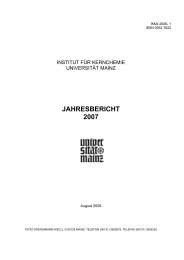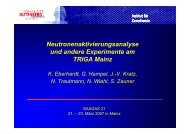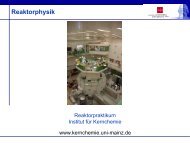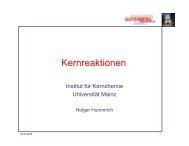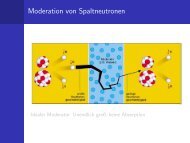institut für kernchemie universität mainz jahresbericht 2009
institut für kernchemie universität mainz jahresbericht 2009
institut für kernchemie universität mainz jahresbericht 2009
Create successful ePaper yourself
Turn your PDF publications into a flip-book with our unique Google optimized e-Paper software.
Evaluation of P-Glycoprotein Modulation of [ 18 F]Fallypride<br />
Piel, Markus 1 ; Schmitt, Ulrich 2 ; Bausbacher, Nicole 3 ; Buchholz, Hans-Georg 3 ; Hiemke, Christoph 2 ; Rösch, Frank 1<br />
1 Institue of Nuclear Chemistry, Johannes Gutenberg-University Mainz, 55128 Mainz, Germany; 2 Department of<br />
Psychiatry and Psychotherapy, Universitätsmedizin Mainz, 55131 Mainz, Germany; 3 Department of Nuclear Medicine,<br />
Universitätsmedizin Mainz, 55131 Mainz, Germany.<br />
Introduction: P-gp is a member of the highly conserved<br />
superfamily of ATP-binding cassette (ABC) transporter<br />
proteins and acts as an active efflux pump for a wide<br />
range of compounds, including a number of drugs and<br />
steroid hormones. P-gp at the BBB thus regulates<br />
intracerebral concentrations and may affect the PET<br />
imaging of ligands that are substrates of this transporter<br />
[1]. Therefore, we examined possible interactions between<br />
P-gp and [ 18 F]fallypride, which is a routinely used high<br />
affinity ligand to determine the D2-receptor status in vivo<br />
[2].<br />
Experimental: [ 18 F]fallypride was synthesised as described<br />
elsewhere [3] and formulated in isotonic saline<br />
solution containing 10% ethanol. 25-30 MBq of the tracer<br />
were then applied to Sprague Dawley rats. Half of them<br />
were treated with the P-gp inhibitor cyclosporine A (50<br />
mg/kg i.p.) 30 min before injection of [ 18 F]fallypride. In a<br />
second experimental series, P-gp KO (mdr1a/b -/-) and<br />
wild type mice, with or without cyclosporine A treatment,<br />
were used in ex vivo biodistribution studies to determine<br />
the brain uptake of [ 18 F]fallypride.<br />
Results: In Sprague Dawley rats, µPET imaging showed<br />
the same trend in uptake kinetics of [ 18 F]fallypride for<br />
both groups (cf. Figure 1). In the control group, a BP of<br />
13.7 and a SUV of 2.5 at 60 min was observed in the<br />
striatum, while the blockade group gave a BP of 8.7 and a<br />
SUV of 4.2 in the striatum. In the mouse models the<br />
determined brain uptake resulted in 2.62 %ID/g in KO,<br />
2.29 %ID/g in treated and 1.68 %ID/g in untreated wild<br />
type mice.<br />
Standard Uptake Value<br />
6<br />
5<br />
4<br />
3<br />
2<br />
1<br />
0<br />
0 500 1000 1500 2000 2500 3000 3500<br />
Time p.i. [sec]<br />
striatum unblocked<br />
cerebellum unblocked<br />
striatum blocked with CsA<br />
cerebellum blocked with CsA<br />
Figure 1. Plot of striatal and cerebrellar [ 18 F]Fallypride uptake<br />
for blocked and unblocked Sprague Dawley rats<br />
- B20 -<br />
Conclusions: In the rat model, the treated animals showed<br />
a reduction of the BP compared to the untreated animals,<br />
due to an increased unspecific uptake in the cerebellum<br />
(cf. Figure 2). Besides, generally higher SUVs were found<br />
which result from a global increase of radioactivity in the<br />
brain under blockade conditions. In mice, a similar effect<br />
showed an increasing uptake from wild type to treated and<br />
KO mice. It is assumed that not all P-gp transporters could<br />
be blocked by cyclosporine A, resulting in an additionally<br />
increased uptake in KO mice. These results indicate that<br />
[ 18 F]fallypride is a substrate of P-gp and therefore its<br />
uptake is modulated by this efflux pump.<br />
control blocked P-gp<br />
Figure 2: [ 18 F]Fallypride sum images (0-60 min p.i.) of untreated<br />
(left) and with cyclosporine A treated (right) Sprague Dawley<br />
rats.<br />
References<br />
[1] Uhr M, Tontsch A, Namendorf C, Ripke S, Lucae S, Ising<br />
M, Dose T, Ebinger M, Rosenhagen M, Kohli M, Kloiber S,<br />
Salyakina D, Bettecken T, Specht M, Pütz B, Binder E B,<br />
Müller-Myhsok B, Holsboer F (2008) Polymorphisms in the<br />
Drug Transporter Gene ABCB1 Predict Antidepressant<br />
Treatment Response in Depression, Neuron 57: 203-209.<br />
[2] Mukherjee Y, Yang Z-Y, Das M K, Brown T (1995)<br />
Fluorinated benzamide neuroleptics—III. Development of<br />
(S)-N-[(1-allyl-2-pyrrolidinyl)methyl]-5-(3-[ 18 F]fluoropropyl)-2,3-dimethoxybenzamide<br />
as an improved dopamine D-2<br />
receptor tracer, Nucl. Med. Biol. 22: 282-296.<br />
[3] Siessmeier T, Zhou Y, Buchholz HG, Landvogt C,<br />
Vernaleken I, Piel M, Schirrmacher R, Rösch F,<br />
Schreckenberger M, Wong DF, Cumming P, Grunder G,<br />
Bartenstein P (2005) Parametric mapping of binding in<br />
human brain of D-2 receptor ligands of different affinities, J.<br />
Nucl. Med. 46: 964-972.<br />
[4] Schmitt U, Abou El-Ela A, Guo1 L J, Glavinas H, Krajcsi P,<br />
Baron J M, Tillmann C, Hiemke C, Langguth P, Härtter S<br />
(2006) Cyclosporine A (CsA) affects the pharmacodynamics<br />
and pharmacokinetics of the atypical antipsychotic amisulpride<br />
probably via inhibition of P-glycoprotein (P-gp), J.<br />
Neural Transm. 113: 787-801.



